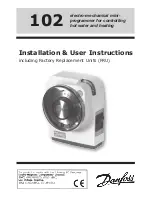
6 720 820 872 (2016/12)
CR 400 | CW 400 | CW 800
10 | Installation
3.3
Installation in the reference room
Fig. 5
Installation of plinth
3.4
Electrical connection
Power is supplied to the user interface via the BUS cable.
The leads may be connected to either pole.
Maximum total length of BUS connections:
•
100 m with 0.50 mm
2
conductor cross-section
•
300 m with 1.50 mm
2
conductor cross-section.
▶ If several BUS nodes are installed, maintain a minimum
clearance of 100 mm between the individual BUS nodes.
▶ If several BUS nodes are installed, connect the BUS nodes
in series or in a star pattern.
▶ To avoid inductive interference: make sure all low-voltage
cables are routed separately to mains voltage cables (min.
clearance 100 mm).
▶ In the case of external inductive interferences (e.g. from
photovoltaic systems), use shielded cables (e.g. LIYCY)
and earth the shield on one side. The shield should be
connected to the building's earthing system, e.g. to a free
earth conductor terminal or water pipes, and not to the
earth lead terminal in the module.
▶ Establish a BUS connection to the heat source. Depending
on the installed heat source the terminal designation is
different there.
Fig. 6
Connection of the user interface to a heat source
The installation surface on the wall must be
flat.
When installing on a wall box:
▶ Fill the wall box with thermal insulation
material to prevent falsification of the
room temperature measurement by
drafts.
▶ Install plinth on a wall (
Æ
Fig. 5).
6 720 645 407-04.1O
6 mm
3,5 mm
6 mm
3,5 mm
If the maximum total length of the BUS
connections between all BUS nodes is
exceeded or the BUS system has a ring
structure, commissioning of the system is not
possible.
6 720 812 361-04.2O
BUS
BUS/
EMS/BB
Summary of Contents for CR 400
Page 63: ...6 720 820 872 2016 12 CR 400 CW 400 CW 800 63 Notes ...
Page 64: ......











































